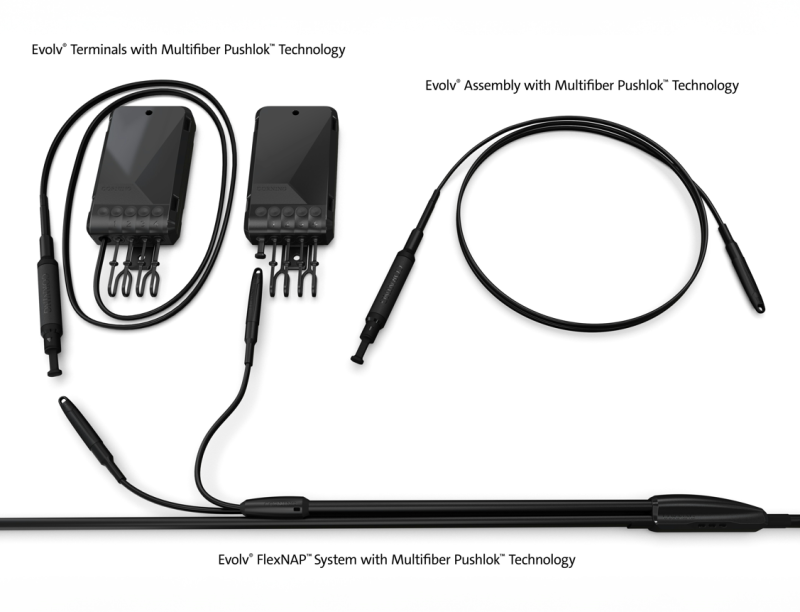-
Corning launched Multifiber Pushlok, a multi-strand fiber connector that beefs up three products in its Evolv portfolio
-
Market Development Manager Jonathan Brady said the company already has customers lined up for the technology, which will help operators deploy their networks faster
-
The release of Multifiber Pushlok ties into the BEAD funding opportunity
Bigger isn’t always better, and that especially goes for fiber. Corning has some tricks up its sleeve to fit fiber cables into every nook and cranny.
Corning last week beefed up its Evolv portfolio with the launch of Multifiber Pushlok, a “stick-and-click” connector that the vendor said allows operators to deploy more fiber in tighter spaces, while reducing costs and labor requirements.
The Pushlok plug-and-play lineup has existed for several years now. But now, instead of just having a single fiber connector, Corning has made a connector that can fit from two to 12 fibers, said Market Development Manager Jonathan Brady.
The company has integrated Multifiber Pushlok technology into three Evolv products: Assemblies, Terminals and its FlexNAP preconnectorized cable solutions. Brady told Fierce the Pushlok technology has not only allowed Corning to make its terminals much smaller but to “help operators connect quicker.”

He noted Corning’s "hardened connectivity" solutions, which include the Pushlok products, have helped operators around the world reach more than 100 million homes. Brady didn’t provide specifics on how many customers have said they plan to use Multifiber Pushlok, just that the company has “customers lined up that are in the design and planning stages to implement it.”
The ports on Corning’s Multifiber Pushlok terminals “are the same size for single fiber and multi-fiber connectors,” he explained. “For our customers and the market in general that are looking to fit a lot of fibers into a small space, our terminals and connectors are now able to do that in a way that makes it simpler to deploy.”
So, can Multifiber Pushlok make it easier for operators to run fiber to say, apartment buildings? It’s for sure a possibility, said Brady.
“It depends on what kind of applications an operator would be interested in using it for,” he said. “Whether it’s multi-dwelling units, whether it’s in suburban, more single-family home applications, this technology has uses anywhere you would want multiple fibers.”
For FlexNAP specifically, the technology lets the cable fit into 1.25-inch ducts, compared to Corning’s legacy connectors that are constrained to 2-inch ducts.
“So now, an operator that has been deploying FlexNAP or that is deploying bulk cable” can use the pre-connectorized system in an 1.25-inch duct, Brady said, instead of deploying bulk cable and having to splice it.
Pre-connectorized cables are being used by all the large telcos in North America, said Dell'Oro analyst Jeff Heynen. In the past, technicians would splice the fibers on site before connecting them - a time consuming process, especially in larger deployments.
"There is definitely a shortage in skilled splicing technicians, so eliminating that step by using pre-connectorized cables is important for operators and their construction partners to hit their KPIs," Heynen said.
Heynen also brought up a few benefits for MDU deployments. The density range of Corning's Pushlok solutions allows operators to "address many different MDU sizes and types." And pre-connectorized cables can reduce the overall time it takes for installation from the curb to the building for each MDU floor.
Furthermore, the ability to push fiber through 1.25-inch ducts is important because ISPs will "often run into situations with older buildings where space to run ducts might be limited." Nokia is another company that's aimed to make it easier for operators to deliver broadband to apartment buildings.
"MDU owners generally want to minimize the disruption to tenants of a fiber deployment. So, anything that reduces the time and cost it takes to get the building and all the apartments connected is going to be preferred," Heynen added.
For Corning’s part, the company found customers deploying FlexNAP “can deploy their networks five times faster” compared to companies using a traditional splice solution.
“What would take five business days or a whole week, you can [now] do in a single day,” Brady said, noting that deploying the system into smaller ducts can cut an operator’s carbon footprint by roughly 50%.
Other fiber optic vendors are also on the move to make their components more compact. Cisco just came out with a new pluggable that collapses the optical line terminal chassis, allowing operators to better manage their PON networks.
In the driver’s seat for BEAD
The crux of the Multifiber Pushlok release, according to Brady, is “the historic opportunity to connect the unconnected,” i.e; the Broadband Equity, Access and Deployment (BEAD) program.
Although Multifiber Pushlok was not specifically made for BEAD, Corning thinks the technology will have “a lot of applications" for BEAD and beyond.
Brady said Corning since 2020 has invested more than $500 million in fiber and cable manufacturing (which includes money to build new fiber optic plans in Arizona and even in Poland).
“The current wave of public and private investments in broadband expansion signals the start of a major growth cycle for fiber-fed communications networks,” he added, also stating Corning is “uniquely positioned” for this opportunity.